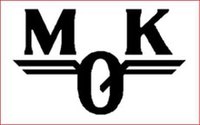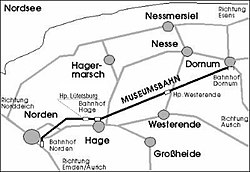Museum railway coastal railway East Friesland
| Museum Railway Coastal Railway Ostfriesland eV (MKO) |
|
|---|---|

|
|
| legal form | registered association |
| founding | February 25, 1987 |
| Seat | north |
| Chair | Christian Walther (Chairman), Tronje Suda, Andreas van Dieken |
| Website | www.mkoev.de |
| North Hage Dornum | |||||||||||||||||||||||||
|---|---|---|---|---|---|---|---|---|---|---|---|---|---|---|---|---|---|---|---|---|---|---|---|---|---|
|
Route map of the historic coastal railway (2019)
| |||||||||||||||||||||||||
| Course book section (DB) : | earlier 221g (12399) | ||||||||||||||||||||||||
| Route length: | 16.45 km | ||||||||||||||||||||||||
| Gauge : | 1435 mm ( standard gauge ) | ||||||||||||||||||||||||
| Top speed: | 40 km / h | ||||||||||||||||||||||||
|
|||||||||||||||||||||||||
The Museumseisenbahn coastal railway Ostfriesland eV ( MKO ) is an association based in the north whose aim is to maintain the operational maintenance of the section of the historic coastal railway between the former district town of Norden and the municipality of Dornum . The railway line along the East Frisian North Sea coast was once part of the continuous connection between Emden and Jever . Opened in 1883, passenger traffic between the north and Esens was initially discontinued in 1983 . The section between Dornum and Esens was finally shut down on September 27, 1985 and dismantled the following year. A cycle path has been on the route since 1990.
history
The further decline in freight traffic in the 1980s was the reason that the Deutsche Bundesbahn also considered a closure between the north and Dornum. This request caused the MKO to be founded by seven railway enthusiasts. On 25 February 1987, the step was taken since the association is the association register Aurich registered and recognized charity.
The first special trips on the route to Dornum followed on the weekend of Pentecost June 7th and 8th, 1987. In the absence of an own fleet of vehicles, so-called conversion wagons with the Norder train station locomotive of the type Köf II were initially used. Around 3,000 tickets sold this weekend testified to the success of the initiative, so that by the end of 1987 corresponding trips were offered on three additional weekends.
With the Köf 6152 (type Köf II) came 1989 the first own locomotive from the bankruptcy estate of the Emder Nordferro-Eisenschwammwerke to the MKO. In the same year, the DB was able to take over a former construction train wagon, which was put into service as car 21 after its restoration.
After the cessation of freight traffic on the north - Dornum line, the MKO was finally able to lease the line and the locomotive shed in Norden, which had been used by the DB until then.
In 1990 the association was able to acquire a pair of conversion cars. At the same time, the Köf 6152 locomotive was transferred north after the main inspection at the Emden depot , so that for the first time since the association was founded, its own train was available. In the further course of the year, the DB was able to take over two more construction train cars intended for scrapping, which after thorough renovation are still used today as cars 22 and 23.
The district of Aurich was able to acquire the coastal railway section between the north and Dornum from the Federal Railroad in 1991. The neighboring communities of Norden, Hage , Großheide and Dornum bought the route from the district and have since leased it to MKO. Two years later, the British Army of the Rhine was able to acquire locomotive 2, which in turn went into operation for the main inspection at the Emden depot and on May 12, 1994 under the name "Dornum".
As part of a training and learning measure (A&L) for young people without school qualifications or vocational training, the former "Nm" signal box , which only exists as a base, was rebuilt in 1996 in addition to the renovation of the locomotive shed in the north .
The Bundeswehr sold 1997 unnecessary shunting of the Navy ammunition depot Aurich to the MKO, the 3 "North" took the locomotive in the following year as a locomotive in operation.
In cooperation with the community of Großheide, the Westerende stop, which had been closed since the 1960s, was reopened on April 15, 2000. Finally, in November of the same year, the G 10 “Karlsruhe 47 103” type G 10 “Karlsruhe 47 103” freight car that was taken over from the DB in Emden in 1999 was added to the inventory. The car has been advertising the Onno Behrends tea house in North since it was put into service. A six-cylinder diesel engine with a generator with an output of 75 kVA was installed inside, which generates electricity for its own heating and lighting in the cold season.
In October 2003, the Belgian state railway NMBS / SNCB acquired the Reeks 8062 locomotive, which was identical in construction to the German V 60 series .
The “Dornum” locomotive was sold to the Hasetal-Haselünne railway friends in October 2004 and transferred on its own on October 31. In Dornum, the new, club-owned train station building was completed and inaugurated in June 2005. The predecessor from the Bundesbahn era had already been canceled in 1979.
From 2006 to 2009 extensive construction work took place in the section between the north and Hage. The new bypasses of Lütetsburg and Norden ensured, on the one hand, a partial relocation of the tracks and, on the other hand, the construction of mostly signal and barrier-protected level crossings. In this context, the Lütetsburg stop was also rebuilt. At the end of 2009, the reconditioning and re-commissioning of the V 60 locomotive from Belgium was completed. The association received the necessary operating license the following year and was able to name the locomotive "Dornum" on May 16, 2010. It was given the road number V 60 062. At the end of 2010, the long-term purchase negotiations with DB also led to success, with the conclusion of which the MKO became the owner of the locomotive shed and former depot area in Norden.
In 2015 the Mittelweserbahn sold the V 662 (DB 260 555-8) locomotive to MKO, which has been used on the coastal railway in alternation with the V 60 062 since the main inspection. In return, the previous “Norden” locomotive was sold to the Bremerhaven-Bederkesa museum railway . In addition, the Aurich-Emden mbH (EAE) railway infrastructure company gave the club the no longer needed Klv 53-4737 and trailer.
vehicles
The association collects historical material about the railway system. The vehicle collection in 2019 comprises around 30 standard gauge vehicles . Of these, three diesel locomotives, three freight cars, three passenger cars and some construction vehicles are operational. In the north, the locomotives are sheltered from the weather in the listed locomotive shed. The two locomotives of the V 60 series are used alternately in front of the trains on the coastal railway on operating days; all other vehicles can be viewed in the summer months during the museum's opening hours.
The regularly coming for use on the coast railway train set normally consists of a locomotive V 60, the wagon G 10, the covered austauschbauart Glr "Dresden 80001", the two Donnerbüchsen MKO 22 and 23 and the thunder bush 21, the half to Zugbistro was rebuilt.
The Köf 6152 "Helga", two Klv 53 Rottenkraftwagen, a road- rail excavator and other flat and freight wagons are available for track construction work.
| designation | design type | Manufacturer | Construction year | origin | annotation | |
|---|---|---|---|---|---|---|
| Helga | Köf II | Gmeinder | 1953 | German Federal Railroad 322 041-5 | most recently Nordferro , Emden | |
| 260 555-8 | V60 | Croup | 1960 | Deutsche Bundesbahn 360 555-7 | most recently Mittelweserbahn V662 | |
| V60 062 "Dornum" | V60 | La Brugeoise et Nivelles , Bruges (B) | 1963 | Belgian State Railways NMBS / SNCB 8062 | ||
| MKO 21/22/23 | DRG Ci 84024 (21) / 84908 (22/23) | unknown | 1928 | German State Railroad Company | ||
| "Karlsruhe 47 103" | G 10 | unknown | 1922 | German State Railroad Company | ||
| "Dresden 80001" | Glr | Left-Hofmann-Busch | 1927 | German State Railroad Company | ||
| Rottenkraftwagen | Klv 53 | Robel & Co. | 1975 | German Federal Railroad | Second Klv 53 from EAE in stock |
literature
- The coastal railroader is the official organ of the Museumseisenbahn coastal railway Ostfriesland eV (MKO)
- Jörg Kreuzmann: History of the coastal railway . Self-published, Norden 2013







